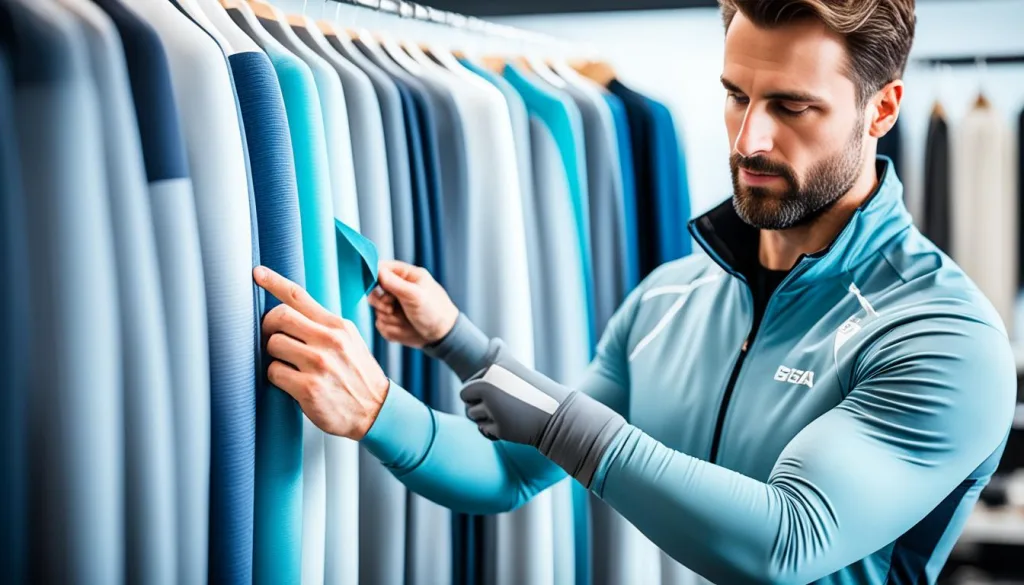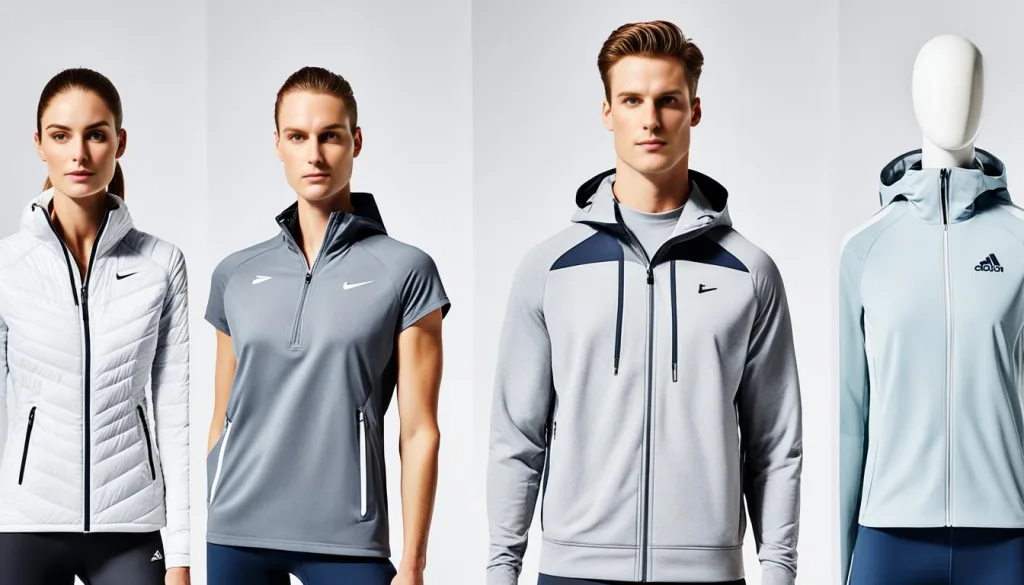The Buying Journey of a Sportswear Consumer: From Awareness to Purchase
Connect With Us Today
Consider us for your next production run. Why wait? Send us your questions here.
The path a sportswear shopper takes begins with an initial interest and ends with a purchase. A notable 54% of consumers use search engines to find sportswear product info1. This shows brands must be easy to find online. Additionally, 56% of shoppers mainly use smartphones for research and reviews on products1. This means the shopping process should work well on phones. Brands need to understand how consumers decide to buy sportswear. This helps make the buying journey better.
Key Takeaways
- Understanding the sportswear buying cycle is key to engaging consumers effectively.
- Utilizing SEO to optimize for search engines can significantly impact consumer awareness.
- Creating a sportswear shopping process that leverages mobile technology optimizes engagement with the majority of consumers.
- Personalization and targeted content are essential for a refined sportswear shopping experience.
- Strategies to help consumers along their journey include offering in-depth product information and helpful reviews to inform their purchasing decisions.
Unraveling the Sportswear Consumer Mindset
As the sportswear market grows, understanding the consumer mind is key. Brands need to connect with what consumers want and how they see brands. The world of sportswear shoppers is complex and full of expectations, identity, and brand impact. We look into consumer behaviors and market trends to find out what makes people buy sportswear.
Identifying Sportswear Consumer Needs
Sportswear buyers look for more than just utility today. They want style, comfort, and the latest tech in their clothes. The industry, worth over USD$350 billion2, sees consumers choosing gear for both life and fitness. This growth comes as online sales for brands like ASOS and lululemon rise from 2019 to 20202. It shows how shopping habits are changing, pushing brands to meet shoppers online.

The women’s activewear sector has exploded in the past decade2. Buyers want inclusivity and choice in their sportswear. Big names like Adidas, Nike, and Under Armor have expanded their women’s lines. Adidas even reports faster growth in women’s wear than men’s2.
Understanding Consumer Motivations in Sportswear
People buy sportswear for many reasons, from fitness goals to enjoying athleisure as a trend. Athleisure has grown strong, even as other areas struggled during the COVID-19 pandemic2. This shows a change in how we live, blending work, rest, and fitness. Sportswear today must fit exercise needs and everyday comfort, embodying what motivates modern shoppers.
The Role of Brand Perception in Sportswear Selection
How consumers see a brand is crucial in choosing sportswear. Trust, quality, and sustainability are key to loyalty. A Carbon Trust report says 64% of people think better of brands that cut their carbon footprint3. Stores like The GAP and American Eagle have launched activewear, tapping into these consumer values2. Demands for fast fashion and open production processes are also crucial, reflecting a desire for sustainable and ethical production4.
| Factor | Consumer Impact | Evidence |
|---|---|---|
| Online Sales Increase | Defines shopping preference | ASOS, lululemon sales up between 2019 and 20202 |
| Women’s Activewear Growth | Highlights need for diversity | Exponential growth over 10 years2 |
| Brand Sustainability Focus | Increases brand favorability | 64% view brands reducing carbon footprints more positively3 |
| Consumer Transparency Demand | Shifts towards ethical production | Transparency in fashion value chain demanded4 |
The sportswear shopper’s mindset is unique, prioritizing sustainability, inclusion, and tech. Brands that quickly adapt and align with these values will lead the future of activewear. They shape the journey with every new innovation.
The Foundational Stage: Developing Awareness
Developing awareness in the sportswear buying journey is crucial. It helps guide the buyer from finding the brand to buying. For brands, it’s more than just ads. It’s about telling a story that shows what makes them special.
Influencing through thought leadership and digital platforms is key. This increases knowledge of the brand and sharpens its profile.
Creating experiences that connect with customers on different levels proves that various marketing strategies work. Influencer partnerships make brands more relatable. Content full of information positions a brand as a trusted source. Using these strategies shows understanding of today’s buyers. They want to buy and also be informed and involved.
Content that educates is very powerful. Articles and videos that explain product benefits, like better performance or eco-friendly materials, are meaningful to eco-conscious buyers. This approach boosts brand knowledge and shows the brand values transparency.
By improving customer knowledge, brands build stronger connections. These go beyond just buying and selling.
Marketing that uses social media helps brands share their true story. Mixing natural and paid methods makes sure the right people hear these stories. Tales of lasting quality, innovation, or ethical making attract and keep customers.
Being quick to respond to product questions or after-sales support is key. Fast responses show a brand cares about its customers. This is essential for building loyalty.
Statistics show the importance of building strong relationships between consumers and brands:
- Engaging early with comprehensive strategies helps understand what consumers need and like5.
- Aiming for customer delight strengthens a brand’s reputation for great value and satisfaction5.
- But, raising brand awareness is more than first meetings. Brands work to claim a bigger spot in a consumer’s spending on their product category5.
A clear plan for raising awareness in the sportswear buying journey results in well-informed and loyal customers. Sportswear brands use this strong base to better navigate the consumer market, leading to more repeat buyers and loyalty.
Comparative Analysis: Evaluating Sportswear Options
Starting to choose the right sportswear requires looking closely at many factors. This approach began in the 1940s—1950s. It combined marketing with studies of how people act and what they want6. Now, picking sportswear is not just about looks. It’s about the brand, the quality, and how it matches who you are6.
When people compare sportswear, they use what they’ve learned before. This includes how they feel, think, and react to what’s around them6. Research from the 1950s showed us that our choices often stem from our feelings or thoughts6.
| Brand | Price | Quality | Durability | Design |
|---|---|---|---|---|
| Nike | $$$ | High | Long-lasting | Innovative |
| Adidas | $$ | High | Robust | Classic |
| Under Armour | $$ | Medium | Moderate | Athletic |
| Puma | $ | Medium | Standard | Trendy |
The table shines a light on how to analyze sportswear by looking at important factors. These factors come from a mix of psychology, society, and economy6. They help understand why people buy what they buy6.
Reviews and ratings are key, acting as proof of what’s good or bad. Friends, family, and sports groups also play a big part in what we choose6.

Nowadays, choosing sportswear is very detailed, just like studying how people behave. Brands must use research and data to really understand consumers6. This means looking at how people buy, use, and throw away products6.
In the end, understanding consumer behavior is crucial for comparing sportswear brands and choosing the right sportswear. It helps ensure purchases fit the buyer’s identity and lifestyle6.
Personalization in the Sportswear Shopping Experience
As consumer preferences change and economic challenges rise, brands focusing on personalization in sportswear shopping gain an edge. In 2022, Europe and the United States faced the highest inflation in over 40 years, putting pressure on sportswear companies7. Many consumers cut back on sports spending as a result7.
The economic downturn led to a drop in sportswear purchases. There was less interest in footwear, apparel, and sports equipment7. Brands saw a rise in demand for customized sportswear options that balance cost, quality, and uniqueness. Only 6% of companies felt ready for these inflation challenges7. They expect revenue and profit to drop by more than 5% next year7.
Now, a personalized shopping experience in sportswear is key. For example, in the United States, there was a 4 to 8 percent drop in sales in 2022’s first three quarters7. Athletic footwear and activewear sales also went down by 4 to 6 percent7. Sales of home fitness equipment, except e-bikes, fell by 28%7.
| Category | Revenue Decline in the US (2022) | Notes |
|---|---|---|
| Athletic Footwear & Activewear | 4-6% | Matches general sportswear trends |
| Home Fitness Equipment | 28% | E-bikes continue to grow |
In China, the fast-growing sports goods market slowed down7. Women there spend 15 to 20% more on sports and fitness than men, showing a key group for personalization strategies7. Chinese brands like Anta and Li-Ning are using this to compete, pushing global brands to focus more on women’s sportswear7.
Adopting personalization in sportswear shopping is a strategic decision for brands. Offering customized sportswear options lets customers express themselves. It turns the current economic challenges into opportunities for growth and loyalty.
The Decision Process in Sportswear Purchasing
When buying sportswear, consumers go through a detailed decision-making process. They research extensively for costly, durable items to make the best choice8. However, brand loyalty or the ease of finding products can influence their decisions more than the price. This makes them skip some usual decision-making steps8.
Consumer Reviews and Their Impact on Purchasing Decisions
In our digital world, researching before buying is key. People use feedback from friends, online reviews, and social media to decide on sportswear8. Reviews are crucial as they offer genuine feedback on quality and performance. They help shoppers weigh options based on price, quality, and what they personally prefer8.
Price Consideration and Value Assessment
When buying sportswear, shoppers consider what they value to make a choice. Marketers must highlight product benefits and usage tips to help the buying journey8. Making the final decision involves evaluating these aspects carefully. Marketers aim to simplify this for buyers8. For more on buying stages, visit the buying process stages for insights.
FAQ
What is the buying journey of a sportswear consumer?
How can understanding the buying journey of sportswear consumers benefit brands?
What are the specific needs of sportswear consumers?
What motivates sportswear consumers to make a purchase?
How does brand perception impact the selection process in sportswear?
What strategies can be used to develop awareness among sportswear consumers?
What factors do sportswear consumers consider when evaluating their options?
How can brands offer a personalized sportswear shopping experience?
How do consumer reviews impact sportswear purchasing decisions?
How do sportswear consumers assess the value of products?
Source Links
- https://www.pwc.com/gx/en/industries/consumer-markets/consumer-insights-survey.html
- https://www.ncbi.nlm.nih.gov/pmc/articles/PMC8203820/
- https://www.forbes.com/sites/amynguyen/2021/06/07/carbon-labels-digital-passports-and-traceability-tags–clothing-labels-new-normal/
- https://www.mdpi.com/2071-1050/12/7/2809
- https://www.worldsupporter.org/en/chapter/41634-summary-principles-marketing-kotler
- https://en.wikipedia.org/wiki/Consumer_behaviour
- https://www.mckinsey.com/industries/retail/our-insights/sporting-goods-2023-the-need-for-resilience-in-a-world-in-disarray
- https://courses.lumenlearning.com/clinton-marketing/chapter/reading-buying-process-stages/
Latest News
How Collaboration Shapes Consumer Preferences in Sportswear
Navigating Consumer Rights and Warranties in Sportswear Sales
Artificial Intelligence in Fashion Forecasting and Trend Analysis
The Shift Towards Inclusive Sizing in Sportswear: Consumer Reactions
The Global Expansion of Luxury Sportswear Brands
From Sketch to Gym: The Design Process of Fashionable Sportswear
Understanding the Role of Trade Associations in Sportswear Compliance
How Economic Trends Influence Consumer Spending on Sportswear
Learning from Successful Global Market Entries
Best Practices for Managing Cross-Cultural Teams
Using Technology to Fight Counterfeit Fashion Products
Carbon Nanotube Fabrics for Superior Strength and Flexibility
The Growth of Fitness Tracking Apparel in Health and Wellness
Exploring the Influence of Social Proof in Sportswear Purchasing
Strategies for Managing Compliance in a Multinational Operation
Trends in Global Footwear: Performance Meets Lifestyle
The Role of Artificial Intelligence in Tracking Supply Chain Operations
Evaluating the Success of Sportswear Collaborative Projects
Evaluating the Potential of Emerging Markets
Global Shifts Towards Gender-Neutral Sportswear
Share This Article
Latest Articles



















